The Small Cent Experiment of 1856 to 1864
The Coinage Act of 1792 established the United States Mint in the then-capital of Philadelphia. The Act provided requirements for United States coinage, the creation of various Mint positions and the duties incumbent on the principals and established the United States Dollar as the standard unit of currency.
During the first year of operations, 1793, the Mint struck 35,334 copper Half Cent coins as well as a total of 110,516 of the four types of Large Cents—Chain, Wreath, Strawberry Leaf and Liberty Cap. For the next fifty years, the Mint struck these coins, and they were profitable to strike and distribute as the cost for copper was low.
Silver and gold coins that were also being struck contained their full metallic value, but copper coins were profitable to strike. By 1849, that all had changed, so the Mint began studying ways to make these coins profitable again.
The problem was recognized as early as the 1830s when Dr. Lewis Feuchtwanger tried to develop interest in his “coins,”—One Cent and Three Cent coins—that were comprised of ‘German Silver,’ which was a misnomer, as they were struck from nickel, copper, and zinc. Although he struck thousands of pieces at his own expense, he was unsuccessful in his efforts.
In 1855, the Mint Director, James Ross Snowden, looked at using former Chief Engraver Christian Gobrecht’s design for a Flying Eagle coin as the design for a new and smaller One Cent coin, not comprised of pure copper. Although Gobrecht had died in 1844, his design certainly lived on to be considered. In 1856, the Mint’s refiner, James Booth, determined that a new coin composition of 88 parts copper and 12 parts nickel would be a perfect mixture for a new One Cent coin. The diameter of the new One Cent coin would be reduced from 27.5mm to 19mm. The coin would be thicker and much brighter, but to easily distinguish it from silver coins, the thickness would be increased considerably over any silver coins and the coin would have a plain edge as opposed to a reeded edge as used on silver coinage.
The Chief Engraver for the U.S. Mint, James B. Longacre, was ordered to create new coin designs using the Gobrecht flying eagle. Longacre’s coin faithfully reproduced the Gobrecht design, but on a much smaller planchet. The eagle faced to the left and is depicted in flight. Across the upper periphery are the words “UNITED STATES OF AMERICA,” and the date “1856” is situated on the lower periphery.
The reverse of the coin has an agricultural wreath made up of tobacco, corn, wheat, and cotton leaves with the denomination of “ONE CENT,” on two lines inside of the wreath. The eagle is well-executed and closely resembles Gobrecht’s silver dollars of 1836 to 1839.
The 1856-dated Flying Eagle cents saw an undetermined actual mintage in late November of 1856. Some sources refer to 1,000 coins being struck, while others reported 1,500 or more. It is known that many of these coins were given to federal and local politicians and to newspaper editors—the ‘influencers’ of their day, in hopes of receiving positive press about the coins.
As coin collecting was a rapidly-growing hobby in the United States during the 19th Century, these coins were exceedingly popular and in demand by the small number of collectors who knew about them.
The Coinage Act of 1857 authorized the new Flying Eagle cents, and it resolved that the weight of these One Cent coins would be 4.655 grams and that the composition would be copper and nickel. This Act also repealed the ability for foreign coins to circulate and be accepted for all debts in the United States. Additionally, it required that all worn gold and silver coins that were turned into the Mint would be paid in the new copper-nickel coins.
This would assure that only U.S. coinage would circulate in the United States. Businesses that had typically received and used foreign coinage had to change their long-standing practices. There was tremendous demand for the new copper-nickel coins and for the now-banished foreign silver coins before they all disappeared. While commerce using foreign silver coins may have been outlawed in major cities, rural and sparsely populated areas continued using foreign silver coins in commerce for several decades.
To manage the crowds wishing to exchange their now-illegal coins, the Mint set up a wooden building, with two exchange windows, in its interior courtyard to exchange these obsolete coins for the new copper Flying Eagle cents. One exchange window exchanged old copper half cents and large cents for the new copper nickel coins while the other exchange window traded foreign silver coins for the copper-nickel ones.
To satisfy the demand, the Mint struck 17,450,000 of the new 1857-dated Flying Eagle cents. The following year, 1858, saw the Mint strike 24,600,000 more of these same coins.
The 1858-dated coins were of three distinct types. While exact numbers of how many of each type are unknown, of the three varieties there is one considerably more scarce than the others. The scarce variety is the 1858 over 7 variety, where the remnants of the underlying “7” are visible to the upper right above the “8” digit. This overdate is approximately four to ten times more valuable than the two remaining varieties.
The other two varieties are a Large Letters where the “A” and the “M” in the word “AMERICA,” are joined, and a Small Letters variety where those same letters are separate and distinct. These two varieties are of roughly equal value.
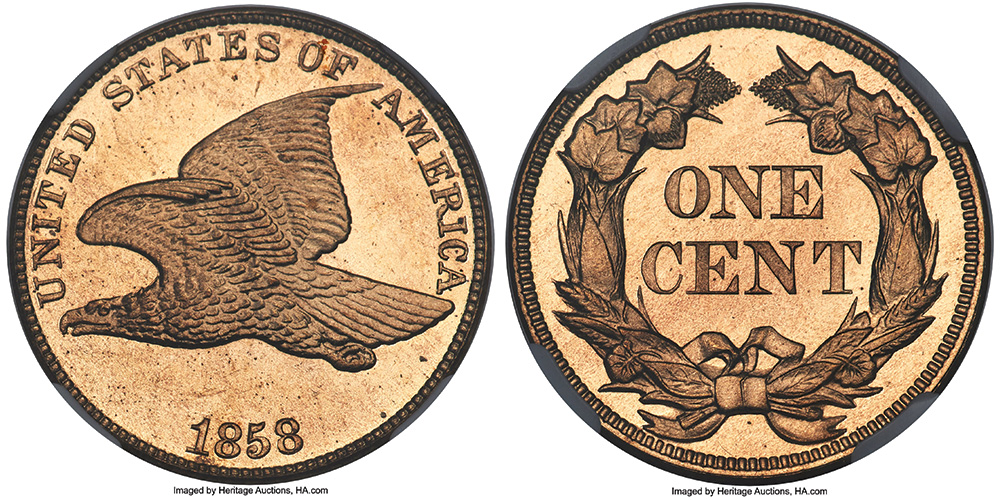
While the American public liked the design, and they certainly enjoyed the new smaller size, the Mint was not satisfied with these coins. The strong details in the eagle design on the obverse were opposite portions of the thick and large wreath on the reverse. Due to this fact, many Flying Eagle cents display weakness on the Eagle’s head or on its tailfeathers.
The Mint designed numerous pattern coins to be considered for regular circulation. Some modified the Flying Eagle cents while others created an entirely new design of a rendition of Miss Liberty wearing a Native American headdress. It mistakenly is mis-described as an Indian Head cent. One of the 1858-dated patterns is truly a compromise piece in that it depicts an Indian on the obverse and a Flying Eagle on the reverse.
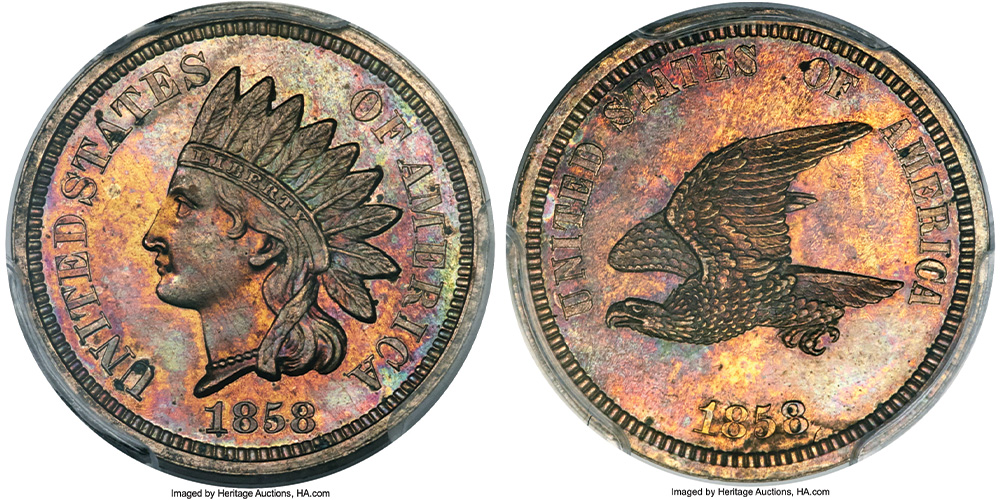
James B. Longacre, who served as the 4th Chief Engraver of the United States Mint, designed this coin. Longacre stated publicly that the obverse figure represented an allegorical representation of Miss Liberty wearing an Indian headdress and does not represent an actual Native American. There were also rumors that the model that Longacre used for Miss Liberty was his own daughter, Sarah. But Longacre himself stated that the model for Miss Liberty was inspired by a statue—Venus Crouching—then-housed in a Philadelphia Museum.
These 1859-dated coins displayed on the obverse a depiction of Miss Liberty, facing to the left, with a Native American headdress atop her head. The motto, “UNITED STATES OF AMERICA,” was on the upper periphery and the date “1859,” was on the bottom periphery.
The reverse of this coin has a laurel wreath on the reverse with “ONE CENT,” in two lines, within the wreath. The Mint struck 36,400,000 of these coins. Inexplicably, the 1859 Indian Head cent with a laurel wreath on the reverse turned out to be a one-year type coin as the reverse changed in 1860.
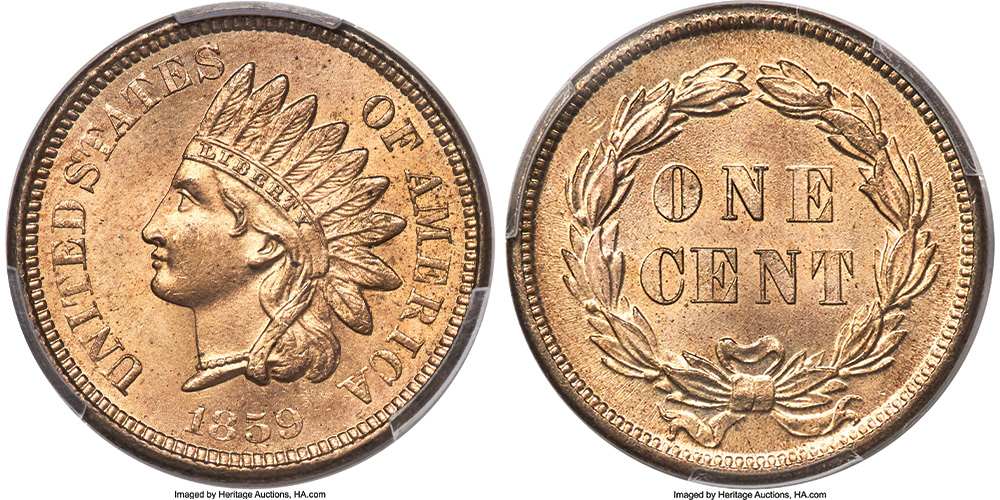
In 1860, the country was in peril. Tensions between northern industrial states and southern agrarian states continued to grow. Abraham Lincoln, the Republican candidate of the North garnered virtually all their votes, while three candidates split the southern vote—Stephen Douglas, John C Breckenridge, and John Bell. In November of 1860, Lincoln was elected and the country teetered on the brink of war. But in December of 1860, the state of South Carolina was the first state to secede from the Union. This was a truly shocking and perilous event for the entire country.
The Mint continued to strike these Indian Head cents, but while the obverse remained unchanged, the reverse, once again, changed with the laurel wreath being replaced with an oak wreath. Additionally, there was a narrow American shield now placed at the top of the wreath. There is no official record as to why this change was made but it was. Meanwhile, the Mint churned out another 20,566,000 more one cent coins. At that moment in time, Indian Head cents were plentiful, and the coins were available to everyone.
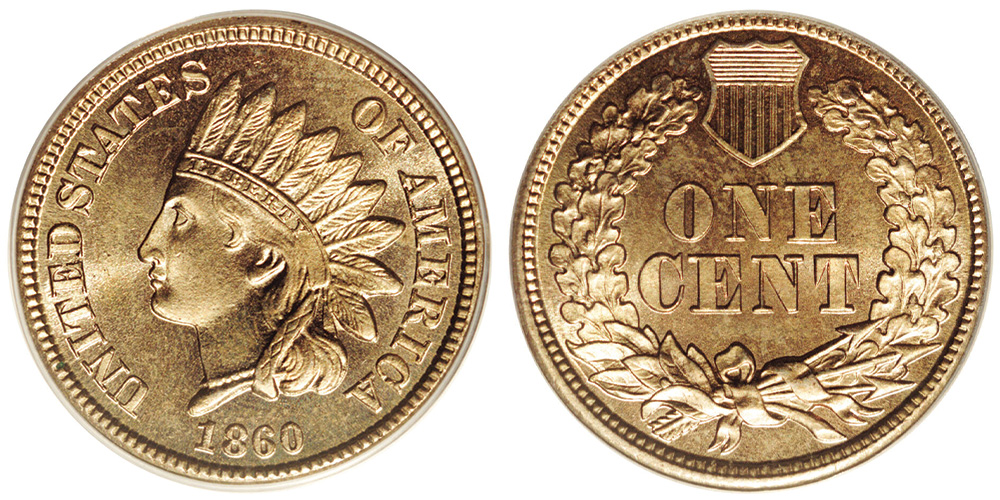
In 1861, several additional states followed South Carolina’s lead. Mississippi, Florida, Alabama, Georgia, and Louisiana all left the Union in January of 1861. In February, Texas followed suit, bringing the number of ‘rebel’ states to seven. On March 4, 1861, the inauguration of Abraham Lincoln took place with him becoming the sixteenth president, the country realized that these two regions had irreconcilable differences. Virginia, Arkansas, North Carolina, and Tennessee brought the number of rebel states to 11. The United States were, seemingly, no longer united.
On April 12, 1861, Fort Sumter in Charleston, South Carolina came under attack from Confederate forces and the war was a reality now. The United States Mint struck 10,100,000 1861-dated copper-nickel cents but as war came to America, all coinage was now being hoarded, not just gold and silver coins. The new Confederate States of America had no coinage or currency of its own so United States currency was accepted everywhere. Three of the United States Mint’s branch offices also fell under Confederate control. Mints in New Orleans, Louisiana, Charlotte, North Carolina, and Dahlonega, Georgia, were occupied by Confederate forces and no longer able to strike Federal coinage. The 1861-dated Indian Head cents were very much in demand.
By 1862, the Civil War was being fought across the country, as far north as Antietam, Maryland and in many of the Confederate states. The Mint attempted to strike more coinage to alleviate the shortage. 28,075,000 1862-dated Indian Head cents were struck, which was a record up to that time. The coin shortage was so severe that the U.S. government allowed debts of up to five dollars to be paid using U.S. postage stamps. The government also printed Postage Currency, also known as Fractional Currency, which could be used as payment for all debts as well.
Merchants across the country were unable to satisfy the demand so a large number of merchants created their own ‘coins’ to be used at their stores. Known today as Civil War Tokens these coins had either merchant advertising or patriotic themes stamped on them and were widely accepted.
During 1863, the Mint struck an amazingly high number of 1863-dated coins—49,840,000 coins—as up to that year, the outcome of the war was truly unknown. By 1864, the tide of the war had turned to the industrial north and 13,740,000 1864 copper-nickel Indian Head cents were struck.
As the Mint had difficulty striking these copper-nickel coins in massive quantities and the life span of the dies was dramatically lower, the Mint changed the composition of the One Cent coin from 88% copper and 12% nickel to 95% copper and 5% tin and zinc. The design was changed imperceptibly as the portrait of Miss Liberty wearing an Indian headdress was strengthened. The overall appearance of these coins looked the same and these new Bronze cents were struck from 1864 to 1909.
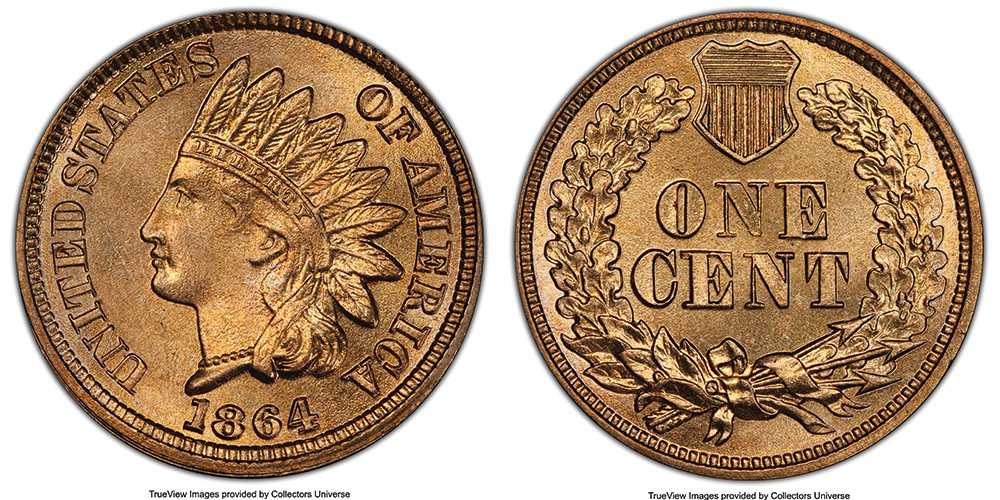
The era of the small cents was here to stay.
Images courtesy of Heritage Auctions, HA.com & TrueView Images by Collectors Universe.

Download the Greysheet app for access to pricing, news, events and your subscriptions.
Subscribe Now.

Subscribe to The Greysheet for the industry's most respected pricing and to read more articles just like this.
Author: Michael Garofalo


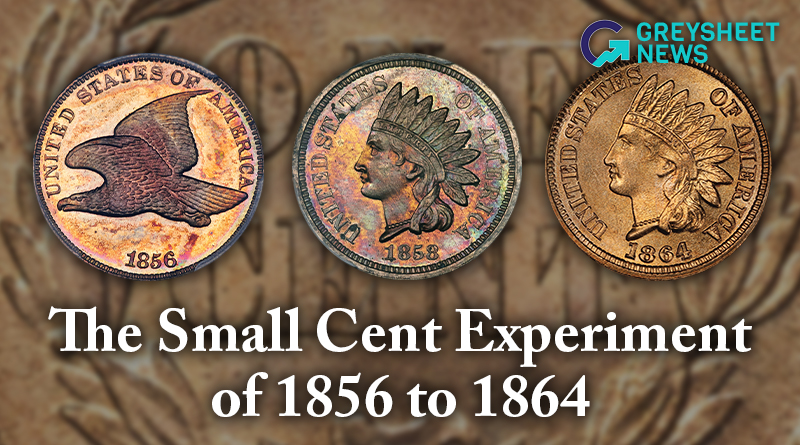






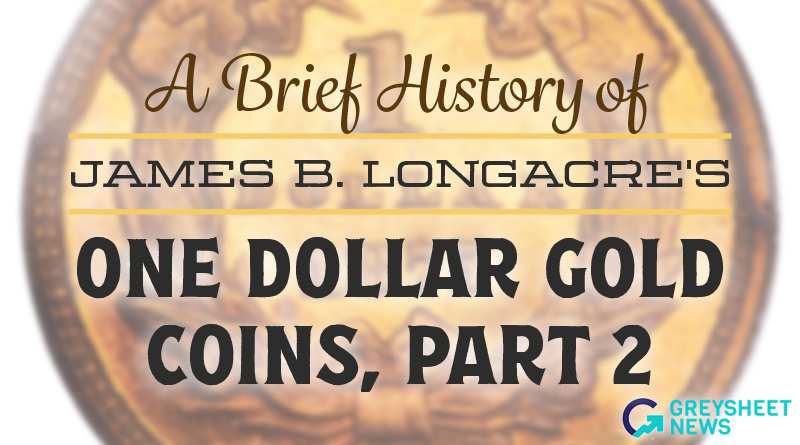
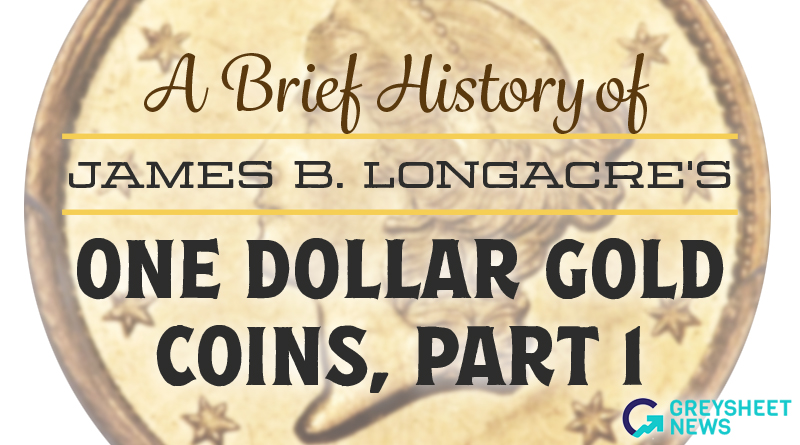

Please sign in or register to leave a comment.
Your identity will be restricted to first name/last initial, or a user ID you create.
Comment
Comments